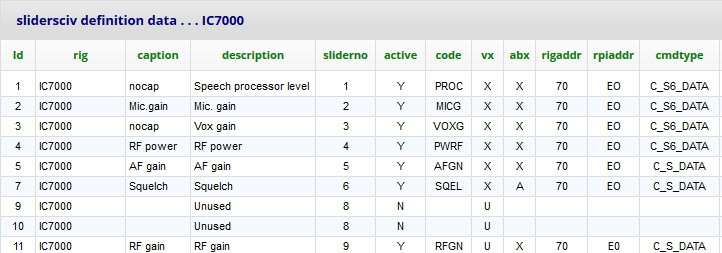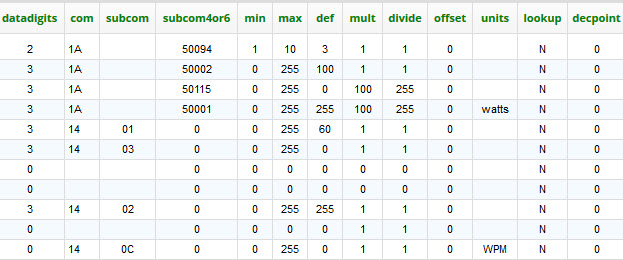6.4 piWebCAT - Database table - slidersciv See sliders configuration notes timing.disable
The configuration of slidersciv follows the same principles as for buttons.
The difference is that all the client and server data is in one large table
(where as buttonsciv referenced table catcodesciv for server functions)
So - at startup, piWebCAT extracts part of the data from slidersciv to store on the client.
The server, on receipt of a command, reads slidersciv from the database for server functions.
The client held data from the slidersciv table includes data for formatting of the numeric text displays
of slider value. Slider values are set when read from the radio at startup and change on slider movement.
slider fields:
- rig The current radio - drop down selector (from radios table)
Must have same spelling through the tables. - description Descriptive text- no function
- caption The caption to the left of the slider. Note that this only applies to the central
column of sliders with no adjacent on/off button with identifying caption. - sliderno The sliders's unique, fixed, numeric identifier. See: Button and slider numbering
- active Y = slider active N = slider inactive (drop list selector)
- code 3 or 4 upper case characters. This links slider movement action on the client
to its action processes on the server. It is transmitted to the server with data (jobdata)
See below for more explanation. - vx vx = V, X or U. Client field that controls storage of latest setting for each VFO.
vx is set to V for dual receiver settings if the radio stores a different value per receiver. - abx A or B if there is pair of entries one for each VFO eg: DNR level, RF gain
X if A or B not relevant. (eg: RF power level, mic gain etc mode) See: vx and abx - rigadr 70 (hex) is the default on some Icon radios
- rpiaddr The controller address - use E0. (Multiple controllers possible with different addresses)
- cmdtype The Icom command type. Control data formatting. See CIV control fields
- datadigits The number of decimal digits in set or answer data. See CIV control fields
- com The hexadecimal command byte.
- subcom The hexadecimal sub command byte. (if used)
- subcon4or6 The decimal sub command (eg: 50014) when cmdtype = C_S6_DATA or C_S4_DATA.
- min The minimum of the CAT data (ie: before scaling etc)
- max The maximum value of the CAT data.
min and max ensure that the range of the sent CAT value spans the
limits of the slider and that the slider response to radio initiated change
also fits the range, - def Default value - set by the associated reset button (not available on all sliders)
- mult Multiplier to scale CAT value for display.
- divide Divider to scale CAT value for display.
eg: use (CAT * 100) / 255 to scale 0-255 to 0 - 100
(Multiply first then divide). - offset Offset applied to display value. eg: offset = -50 scales 0 -100 to -50 to +50.
- units Units after displayed value eg: Hz kHz etc
- lookup If lookup = Y then displayed value is taken from lookup table entries with matching code.
Lookup uses the CAT value after scaling (if any).
If lookup = M then display value from lookup table entry with matching code
and lookup table mode field = current operating mode ( eg: USB, LSB etc).
For lookup = M, lookup table mode must be the mode button's caption -
ie: LSB, USB, CW etc (NOT SSB) See Lookup table .
- decpoint Add decimal point = dec places. eg: decpoint = 3 for 3000Hz to 3.000kHz.
Below is a screen dump of the sliderciv table in the piWebCAT editor.
It is split into left and right parts.


See CI-V configuration - examples